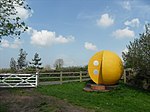Bridgwater and Taunton Canal

The Bridgwater and Taunton Canal is a canal in the south-west of England between Bridgwater and Taunton, opened in 1827 and linking the River Tone to the River Parrett. There were a number of abortive schemes to link the Bristol Channel to the English Channel by waterway in the 18th and early 19th centuries. These schemes followed the approximate route eventually taken by the Bridgwater and Taunton Canal, but the canal was instead built as part of a plan to link Bristol to Taunton by waterway. The early years of operation were marred by a series of legal disputes, which were resolved when the Bridgwater and Taunton Canal Company and the Conservators, who managed the River Tone Navigation, agreed that the Canal Company should take over the Tone Navigation. The canal originally terminated at a basin at Huntworth, to the east of Bridgwater, but was later extended to a floating harbour at Bridgwater Docks on its western edge. Financially this was a disaster, as the extension was funded by a mortgage, and the arrival of the railways soon afterwards started the demise of the canal. The canal was rescued from bankruptcy by the Bristol and Exeter Railway in 1866. Despite commercial traffic ceasing in 1907, the infrastructure was maintained in good order, and the canal was used for the transport of potable water from 1962. The Countryside Act 1968 provided a framework for Somerset County Council to start the restoration of the canal as a leisure facility, which was completed in 1994, when the canal was reopened throughout. Bridgwater Docks have been restored as a marina, but there is no navigable connection to the River Parrett, as the canal still transports drinking water for the people of Bridgwater.
Excerpt from the Wikipedia article Bridgwater and Taunton Canal (License: CC BY-SA 3.0, Authors, Images).Bridgwater and Taunton Canal
Bankland Lane,
Geographical coordinates (GPS) Address Nearby Places Show on map
Geographical coordinates (GPS)
| Latitude | Longitude |
|---|---|
| N 51.063 ° | E -2.989 ° |
Address
Bankland Lane
Bankland Lane
TA7 0DH
England, United Kingdom
Open on Google Maps










